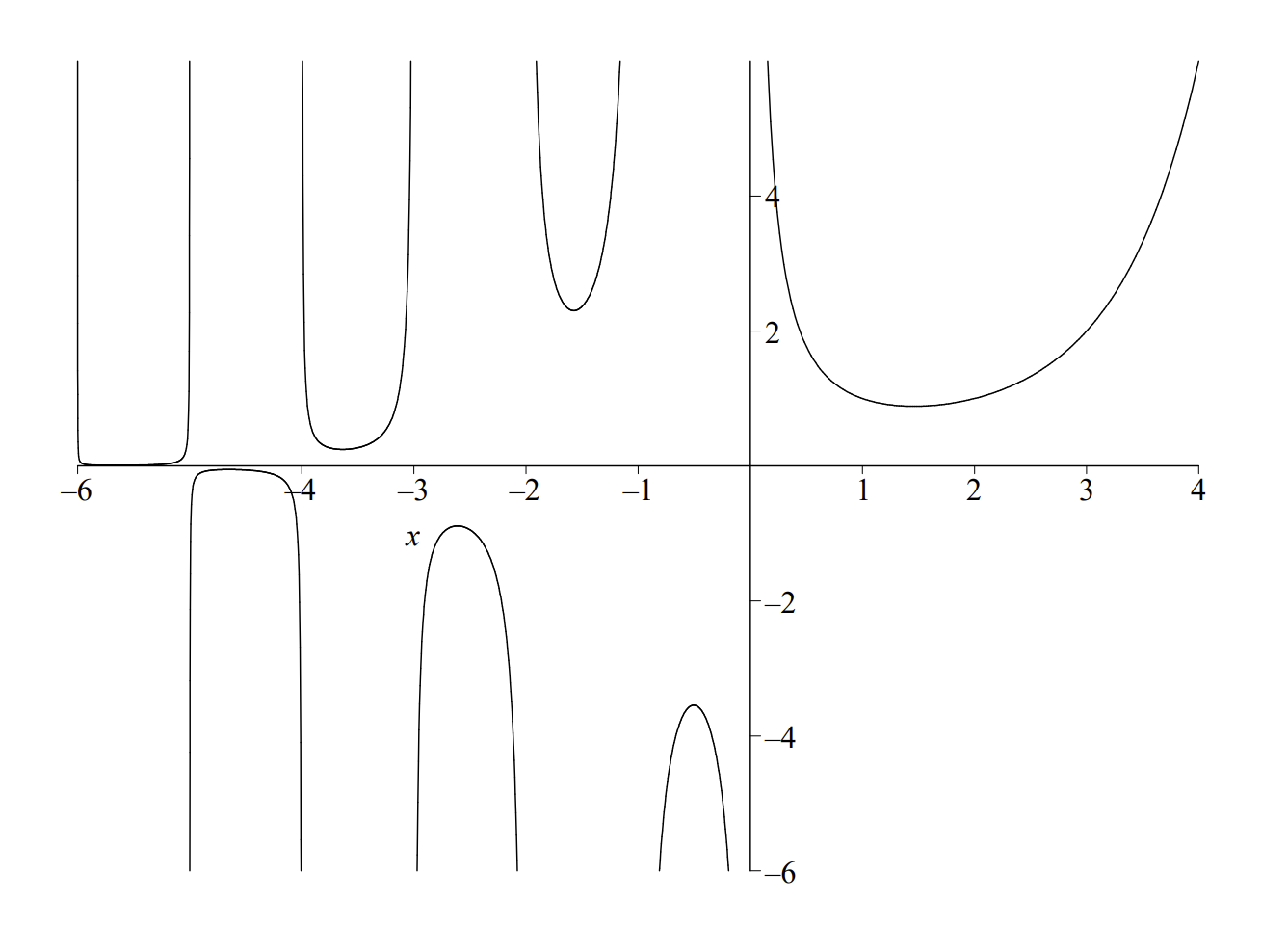4.7: Gamma Function
- Page ID
- 91069
\( \newcommand{\vecs}[1]{\overset { \scriptstyle \rightharpoonup} {\mathbf{#1}} } \)
\( \newcommand{\vecd}[1]{\overset{-\!-\!\rightharpoonup}{\vphantom{a}\smash {#1}}} \)
\( \newcommand{\id}{\mathrm{id}}\) \( \newcommand{\Span}{\mathrm{span}}\)
( \newcommand{\kernel}{\mathrm{null}\,}\) \( \newcommand{\range}{\mathrm{range}\,}\)
\( \newcommand{\RealPart}{\mathrm{Re}}\) \( \newcommand{\ImaginaryPart}{\mathrm{Im}}\)
\( \newcommand{\Argument}{\mathrm{Arg}}\) \( \newcommand{\norm}[1]{\| #1 \|}\)
\( \newcommand{\inner}[2]{\langle #1, #2 \rangle}\)
\( \newcommand{\Span}{\mathrm{span}}\)
\( \newcommand{\id}{\mathrm{id}}\)
\( \newcommand{\Span}{\mathrm{span}}\)
\( \newcommand{\kernel}{\mathrm{null}\,}\)
\( \newcommand{\range}{\mathrm{range}\,}\)
\( \newcommand{\RealPart}{\mathrm{Re}}\)
\( \newcommand{\ImaginaryPart}{\mathrm{Im}}\)
\( \newcommand{\Argument}{\mathrm{Arg}}\)
\( \newcommand{\norm}[1]{\| #1 \|}\)
\( \newcommand{\inner}[2]{\langle #1, #2 \rangle}\)
\( \newcommand{\Span}{\mathrm{span}}\) \( \newcommand{\AA}{\unicode[.8,0]{x212B}}\)
\( \newcommand{\vectorA}[1]{\vec{#1}} % arrow\)
\( \newcommand{\vectorAt}[1]{\vec{\text{#1}}} % arrow\)
\( \newcommand{\vectorB}[1]{\overset { \scriptstyle \rightharpoonup} {\mathbf{#1}} } \)
\( \newcommand{\vectorC}[1]{\textbf{#1}} \)
\( \newcommand{\vectorD}[1]{\overrightarrow{#1}} \)
\( \newcommand{\vectorDt}[1]{\overrightarrow{\text{#1}}} \)
\( \newcommand{\vectE}[1]{\overset{-\!-\!\rightharpoonup}{\vphantom{a}\smash{\mathbf {#1}}}} \)
\( \newcommand{\vecs}[1]{\overset { \scriptstyle \rightharpoonup} {\mathbf{#1}} } \)
\( \newcommand{\vecd}[1]{\overset{-\!-\!\rightharpoonup}{\vphantom{a}\smash {#1}}} \)
\(\newcommand{\avec}{\mathbf a}\) \(\newcommand{\bvec}{\mathbf b}\) \(\newcommand{\cvec}{\mathbf c}\) \(\newcommand{\dvec}{\mathbf d}\) \(\newcommand{\dtil}{\widetilde{\mathbf d}}\) \(\newcommand{\evec}{\mathbf e}\) \(\newcommand{\fvec}{\mathbf f}\) \(\newcommand{\nvec}{\mathbf n}\) \(\newcommand{\pvec}{\mathbf p}\) \(\newcommand{\qvec}{\mathbf q}\) \(\newcommand{\svec}{\mathbf s}\) \(\newcommand{\tvec}{\mathbf t}\) \(\newcommand{\uvec}{\mathbf u}\) \(\newcommand{\vvec}{\mathbf v}\) \(\newcommand{\wvec}{\mathbf w}\) \(\newcommand{\xvec}{\mathbf x}\) \(\newcommand{\yvec}{\mathbf y}\) \(\newcommand{\zvec}{\mathbf z}\) \(\newcommand{\rvec}{\mathbf r}\) \(\newcommand{\mvec}{\mathbf m}\) \(\newcommand{\zerovec}{\mathbf 0}\) \(\newcommand{\onevec}{\mathbf 1}\) \(\newcommand{\real}{\mathbb R}\) \(\newcommand{\twovec}[2]{\left[\begin{array}{r}#1 \\ #2 \end{array}\right]}\) \(\newcommand{\ctwovec}[2]{\left[\begin{array}{c}#1 \\ #2 \end{array}\right]}\) \(\newcommand{\threevec}[3]{\left[\begin{array}{r}#1 \\ #2 \\ #3 \end{array}\right]}\) \(\newcommand{\cthreevec}[3]{\left[\begin{array}{c}#1 \\ #2 \\ #3 \end{array}\right]}\) \(\newcommand{\fourvec}[4]{\left[\begin{array}{r}#1 \\ #2 \\ #3 \\ #4 \end{array}\right]}\) \(\newcommand{\cfourvec}[4]{\left[\begin{array}{c}#1 \\ #2 \\ #3 \\ #4 \end{array}\right]}\) \(\newcommand{\fivevec}[5]{\left[\begin{array}{r}#1 \\ #2 \\ #3 \\ #4 \\ #5 \\ \end{array}\right]}\) \(\newcommand{\cfivevec}[5]{\left[\begin{array}{c}#1 \\ #2 \\ #3 \\ #4 \\ #5 \\ \end{array}\right]}\) \(\newcommand{\mattwo}[4]{\left[\begin{array}{rr}#1 \amp #2 \\ #3 \amp #4 \\ \end{array}\right]}\) \(\newcommand{\laspan}[1]{\text{Span}\{#1\}}\) \(\newcommand{\bcal}{\cal B}\) \(\newcommand{\ccal}{\cal C}\) \(\newcommand{\scal}{\cal S}\) \(\newcommand{\wcal}{\cal W}\) \(\newcommand{\ecal}{\cal E}\) \(\newcommand{\coords}[2]{\left\{#1\right\}_{#2}}\) \(\newcommand{\gray}[1]{\color{gray}{#1}}\) \(\newcommand{\lgray}[1]{\color{lightgray}{#1}}\) \(\newcommand{\rank}{\operatorname{rank}}\) \(\newcommand{\row}{\text{Row}}\) \(\newcommand{\col}{\text{Col}}\) \(\renewcommand{\row}{\text{Row}}\) \(\newcommand{\nul}{\text{Nul}}\) \(\newcommand{\var}{\text{Var}}\) \(\newcommand{\corr}{\text{corr}}\) \(\newcommand{\len}[1]{\left|#1\right|}\) \(\newcommand{\bbar}{\overline{\bvec}}\) \(\newcommand{\bhat}{\widehat{\bvec}}\) \(\newcommand{\bperp}{\bvec^\perp}\) \(\newcommand{\xhat}{\widehat{\xvec}}\) \(\newcommand{\vhat}{\widehat{\vvec}}\) \(\newcommand{\uhat}{\widehat{\uvec}}\) \(\newcommand{\what}{\widehat{\wvec}}\) \(\newcommand{\Sighat}{\widehat{\Sigma}}\) \(\newcommand{\lt}{<}\) \(\newcommand{\gt}{>}\) \(\newcommand{\amp}{&}\) \(\definecolor{fillinmathshade}{gray}{0.9}\)A FUNCTION THAT OFTEN OCCURS IN THE STUDY OF SPECIAL FUNCTIONS is the Gamma function. We will need the Gamma function in the next section on Fourier-Bessel series.
For \(x>0\) we define the Gamma function as
\[\Gamma(x)=\int_{0}^{\infty} t^{x-1} e^{-t} d t, \quad x>0 \nonumber \]
The name and symbol for the Gamma function were first given by Legendre in 1811. However, the search for a generalization of the factorial extends back to the \(1720^{\prime} \mathrm{s}\) when Euler provided the first representation of the factorial as an infinite product, later to be modified by others like Gauß, Weierstraß, and Legendre. The Gamma function is a generalization of the factorial function and a plot is shown in Figure \(4.5\). In fact, we have
\[\Gamma(1)=1 \nonumber \]
and
\[\Gamma(x+1)=x \Gamma(x) \nonumber \]
The reader can prove this identity by simply performing an integration by parts. (See Problem 13.) In particular, for integers \(n \in Z^{+}\), we then have
\[\Gamma(n+1)=n \Gamma(n)=n(n-1) \Gamma(n-2)=n(n-1) \cdots 2 \Gamma(1)=n ! \nonumber \]
We can also define the Gamma function for negative, non-integer values of \(x \). We first note that by iteration on \(n \in Z^{+}\), we have
\[\Gamma(x+n)=(x+n-1) \cdots(x+1) x \Gamma(x), \quad x+n>0 \nonumber \]
Solving for \(\Gamma(x)\), we then find
\[\Gamma(x)=\dfrac{\Gamma(x+n)}{(x+n-1) \cdots(x+1) x}, \quad-n<x<0 \nonumber \]
Note that the Gamma function is undefined at zero and the negative integers.

We now prove that
\[\Gamma\left(\dfrac{1}{2}\right)=\sqrt{\pi}. \nonumber \]
This is done by direct computation of the integral:
\[\Gamma\left(\dfrac{1}{2}\right)=\int_{0}^{\infty} t^{-\dfrac{1}{2}} e^{-t} d t \nonumber \]
Letting \(t=z^{2}\), we have
\[\Gamma\left(\dfrac{1}{2}\right)=2 \int_{0}^{\infty} e^{-z^{2}} d z\nonumber \]
Due to the symmetry of the integrand, we obtain the classic inte-
\({ }^{4}\) Using a substitution \(x^{2}=\beta y^{2}\), we can gral4 show the more general result:
\[\Gamma\left(\dfrac{1}{2}\right)=\int_{-\infty}^{\infty} e^{-z^{2}} d z,\nonumber \]
\[\int_{-\infty}^{\infty} e^{-\beta y^{2}} d y=\sqrt{\dfrac{\pi}{\beta}}\nonumber \]
Which can be performed using a standard trick. Consider the integral.
\[I=\int_{-\infty}^{\infty} e^{-x^{2}} d x\nonumber \]
Then,
\[I^{2}=\int_{-\infty}^{\infty} e^{-x^{2}} d x \int_{-\infty}^{\infty} e^{-y^{2}} d y\nonumber \]
Note that we changed the integration variable. This write this product of integrals as a double integral:
\[I^{2}=\int_{-\infty}^{\infty} \int_{-\infty}^{\infty} e^{-\left(x^{2}+y^{2}\right)} d x d y \nonumber \]
Note that we changed the integration variable. This will allow us to This is an integral over the entire \(x y\)-plane. We can transform this Cartesian integration to an integration over polar coordinates. The integral becomes
\[I^{2}=\int_{0}^{2 \pi} \int_{0}^{\infty} e^{-r^{2}} r d r d \theta \nonumber \]
This is simple to integrate and we have \(I^{2}=\pi \). So, the final result is found by taking the square root of both sides:
\[\Gamma\left(\dfrac{1}{2}\right)=I=\sqrt{\pi} \nonumber \]
In Problem 15, the reader will prove the more general identity
\[\Gamma\left(n+\dfrac{1}{2}\right)=\dfrac{(2 n-1) ! !}{2^{n}} \sqrt{\pi} \nonumber \]
Another useful relation, which we only state, is
\[\Gamma(x) \Gamma(1-x)=\dfrac{\pi}{\sin \pi x} \nonumber \]
The are many other important relations, including infinite products, which we will not need at this point. The reader is encouraged to read about these elsewhere. In the meantime, we move on to the discussion of another important special function in physics and mathematics.


